Jewish Folktales and Talmudic Stories (Page 3) |
If you wish to purchase any of these books, click on either the title or the book cover to be directed to Amazon.com. As a warning, I have put up pictures of the book covers to give you somewhat an idea of the style of each book (I know, I know. "Don't judge a book by its cover") so the pages may load slowly, depending on the speed of your internet connection.
If this page came up without frames, Click here to see the complete website
Other Pages of Interest:
Jewish Folktales and Talmudic Stories for Children
(Page 1)
(Page 2)
(Page 3)
(Page 4)
(Page 5)
(Page 6)
(Page 7)
Easy Reader and Picture Books:
Jewish Children's Books (General) |
Jewish Board Books |
Biblical Stories for Children |
Jewish Holiday Books |
Jewish Family Cookbooks |
Jewish Folktales and Talmudic Stories for Children
(Page 1)
(Page 2)
(Page 3)
(Page 4)
(Page 5)
(Page 6)
(Page 7)
|
Jewish Life Books (Mitzvot, Keeping Kosher, etc.) |
Jewish Life Cycle Books |
Family Haggadahs |
Children's Prayerbooks |
Introductory Hebrew Books |
Jewish History and Historical Fiction Picture Books |
Israel Books
Middle School and YA Books:
Bar Mitzvah Books |
Jewish Fiction |
Historical Fiction |
Torah Study |
Prayer and Jewish Life Books |
Jewish Holidays |
Jewish Biographies |
Jewish History Books |
Holocaust Books for Teens |
Israel Books
Jewish Books for Children |
Bar Mitzvah Books |
Jewish Parenting Books |
Jewish Music for Children |
Jewish Videos |
Jewish Toys and Gifts |
Jewish Gift Baskets and Gourmet Food |
Jewish Jewelry |
Amazon.com Coupons, Promotions, and Sales

Joseph the Tailor: And Other Jewish Tales
Book and Audio Cassette
By Syd Lieberman
Which is your favorite story from Jewish folklore: The story of Joseph,
the tailor who was as resourceful as he was reverent? Or the story of
the wise shoemaker who, when invited to a wedding feast, knew how to
feed his host's appreciation of fine apparel? Whether your favorite is
one of these, or one of the ten other stories in this award-winning
collection, you're sure to be enchanted by Syd Lieberman's mesmerizing
voice, a voice that folklorist Joseph Sobol calls "a powerful tenor
instrument."
Here is the wit and wisdom of traditional Jewish and Biblical stories in
an ALA Notable Children's Recording. Includes 12 stories.
Description from Publisher

The Rabbi Who Flew
By Renate Dollinger
With a playful magic realism reminiscent of the work of Singer and Chagall, Grandma tells a story of a rabbi in the shtetl who is so holy that he flies. The shoemaker's son notices that the rebbe has holes in the soles of his shoes. People will look up at the soaring rebbe, see his shoes, and then what will they think? So the shoemaker and his son devise a plan to measure and mend the rebbe's soles. It's more a scenario than a developed story, but it's told in Grandma's warm Yiddish idiom: the shoemaker's family is beautiful, "may they live to one hundred and twenty." Best of all are Dollinger's vibrant expressionist paintings in rich gouache colors, highlighted with thick black lines. They are packed with people and action, and whether the setting is the street, the crowded shul, or the shoemaker's Shabbat dinner table, the pictures capture the magic that is part of daily life.
Description from Booklist
Written and illustrated by Renate Dollinger, a highly acclaimed Jewish painter, The Rabbi Who Flew is the first in a planned series of "Grandma Hanne Sheyne Stories," and just received a Pewter award in the 2001 Gold Ink Awards Competition (Children's Book). A closer look at the expressive color artwork and rapturous tale reveals why this children's story deserves such an honor. It seems that when Rabbi Frum prays very hard he flies! The problem is that Reb Finkel (the only shoemaker in the village of Gil) is worried that someone looking up as the Rabbi flies over would notice that he had holes in his shoes! What would people think of the "holy" Rabbi then? The Rabbi Who Flew is charmingly presented, exciting, and a highly enjoyable story for young people, presented in such a way as to evoke an atmosphere of Jewish folklore.
Description from Midwest Book Review
 >
>
Onions and Garlic :
An Old Tale
By Eric A. Kimmel
A classic tale about the fool who makes good, while his acquisitive older brothers
are left holding the bag. Kindhearted Getzel is a poor merchant, for he's so eager
to please his customers that he ends up losing money in any bargain. When his
father refuses to give him anything to trade, Getzel begs for some cheap goods and
sets sail with a bag of onions. Value is relative: Getzel is shipwrecked on an
island where onions are an unknown delicacy and diamonds are mere rocks for the
picking. Getzel makes the trade of a lifetime and returns home in triumph. Kimmel
(The
Adventures of Hershel of Ostropol, 1995, etc.) retells this Jewish folktale
(carefully sourced in an author's note) with lively dialogue and a comic twist at
the end.
From Kirkus Reviews, March 15, 1996
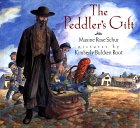
The Peddler's Gift
By Maxine Rose Schur
This new version of a wise fool story originally published as
Shnook
the Peddler (1985), is illustrated in pencil and watercolors that show the
shtetl setting and introduce the characters with gentle humor and grace. A
boy, Leibush, describes how everyone considers the meek peddler
Shimon ("Shnook") from Pinsk to be a simpleton. Nothing he does turns
out right. Other peddlers are jolly entertainers, but Shnook is shy,
trusting, unlucky. One night Leibush steals a dreidel from the peddler.
Racked by guilt, the boy goes out into the stormy night to return it and
finds Shimon alone in the synagogue, singing in a beautiful, vibrant voice.
Shimon is glad that Leibush is not a good thief. They shelter together in
the synagogue, and the boy realizes that the unworldly peddler is wise,
strong, and kind. The detailed, realistic pictures express the quiet
humanity of the story in soft tones of grey and blue--except for the
storm scene, when the boy learns the truth and the world is bathed in
holy light.
Description from Booklist
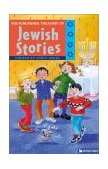
The Kingfisher Treasury of Jewish Stories
By Jane Cope
Ranging from folktales to contemporary stories, this anthology celebrates the richness of the Jewish heritage. The stellar list of contributors includes Isaac Bashevis Singer, Lynn Reid Banks, and Michael Rosen.
Description from Publisher
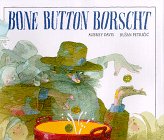
Bone Button Borscht
By Aubrey Davis
In this ethnic variation of "Stone Soup," a hungry beggar comes to a poor town
on a cold and snowy evening. No door is opened to him until he sees a light and
enters the synagogue. The shamas does not answer his greeting so the beggar takes
the five buttons off his coat and asks for one more in order to make Bone Button
Borscht. Bowls, cups, ladles, and a pot wouldn't hurt either, he explains. As the
shamas goes from door to door seeking the ingredients, the incredulous townspeople
gather round and provide the food that will make the soup just a little more tasty.
Such a miracle. Such a joyous feast. The stranger then goes on his way with better
buttons on his coat and the townspeople left with a better spirit of neighborliness.
The retelling provides a satisfying Eastern European setting for a classic folktale.
Watercolor and pencil drawings help to flavor the stew
Description from School Library Journal

G-d in Between
By Sandy Eisenberg Sasso
In a town with no roads and few windows live adults of various races, all
of whom are in search of G-d to build windows and roads for them. The two
residents who have a window in their homes are designated to find G-d. Each
travels far and endures nature's extremes en route, but neither searcher is
successful. Meeting after their exhausting quests, the two spend hours
comforting each other before returning home. The disappointed townspeople
continue to complain about their windowless, roadless existence, while the
two searchers help each other build a road and put windows in each room of
their homes. When asked how they accomplished this daunting feat, they
replied that G-d helped them, for "G-d is in the between. In between us."
Reflecting the author's weighty message with heavy brushstrokes, Sweetland
thickly paints a multicultural populace in a nondescript environment.
Although the message is didactic, this nonsectarian urging to look beyond
oneself, to look to help others and thereby find G-d will be welcomed by
fans of Sasso's
G-d's
Paintbrush (1995) and
Prayer
for the Earth (1997).
Description from Booklist
 >
>
A Treasury of Jewish Stories
By Adele Geras
Ranging from folktales to contemporary stories, this anthology celebrates the
richness of Jewish tradition. The stellar list of contributors includes Isaac
Bashevis Singer, Lynne Reid Banks, and Michael Rosen.

Naftali the Storyteller and His Horse, Sus and Other Stories
By Isaac Bashevis Singer
A collection of short stories which explores the humor and life of the people
of Poland.
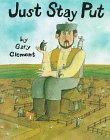
Just Stay Put :
A Chelm Story
By Gary Clement
Chelm, that village of "extremely silly", is the setting of a
splendidly idiotic tale of Mendel, a lazy man with his head
literally in the clouds. After five pages of background
in the ways of Chelm, the real story gets under way: Mendel
embarks on a journey to Warsaw, the city of his dreams. He
takes time for a nap on the way, but points his shoes toward
Warsaw so he won't forget which way he was walking. A would-be
thief examines the shoes and replaces them, pointing Mendel
toward home. This fool, believing he has arrived in Warsaw,
is amazed to find things exactly as they were in Chelm (right
down to the "twin" of his wife), and decides that "if one
place is exactly like every other place, one might as well
just stay put." Clement's witty illustrations depict Mendel
sometimes towering over the village, sometimes in miniature
among giants, always slightly dazed.
Description from Kirkus Reviews
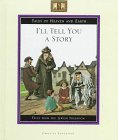
I'll Tell You a Story:
Tales from the Jewish Tradition
By Marc-Alain Ouaknin
The story of Maimonides, whose morality was tested by a
sultan, and other traditional Jewish tales.
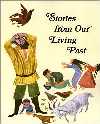
Stories from Our Living Past
By Francine Prose
Twenty-eight tales from the aggadic treasury of lore and legend
that the rabbis called "the Torah of the Heart"--and the moral
lessons they teach. Retold and illustrated for grades 2-3, and
ranging from the Binding of Isaac to Bialik's "moral myth" about
the Dukes of Onion and Garlic. (Pupils will find there is even a
moral lesson in the traditional recipe for tsimmes.)
Description from Publisher
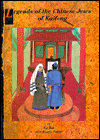
Legends of the Chinese Jews of Kaifeng
By Xin Xu and Beverly Friend
Chinese Jews!
A curious pairing, but strange as it may seem, there have been Jews
in China for more than a thousand years. The country's Jewish
community, located in Kaifeng, once the capital city, numbered
several thousand at its height. Because of China's tolerance and
openness, its members attained success in many fields - commerce,
crafts, government service, the military. Their synagogue, a
unique amalgam of Chinese architecture with Judaic tradition, was
one of the city's most striking sights. The story of Chinese Jewry
is both historically interesting and profoundly inspiring. Long
isolated from other Jews because they were living in a land that
sought to cut itself off from the rest of the world, they
tenaciously maintained their traditions and identity. Though they
adopted Chinese customs and intermarried with their neighbors,
Kaifeng's Jews held together as a community until well into modern
times. Even today there are people in Kaifeng who remain aware of
their ancestry and register as Jews on official census forms.
Of the many fascinating tales related in this beautifully
illustrated, lovingly written book, perhaps the most touching is
the one about Kaifeng's Jews and the first Christian missionaries
in China. The Jews, never having heard of Christianity, assumed
that anyone who believed in one God must be a coreligionist.
The missionaries, never having imagined there might be Jews in
China, assumed they were lost Christians. When the misunderstanding
was cleared up, the Christians set about trying to convert the Jews
but to no avail, because Kaifeng's Jews were adamantly loyal to
their heritage.
Description from Publisher

Brainteasers from Jewish Folklore
By Rosalind Charney Kaye
A lavishly-illustrated collection of folktale riddles in which peasants
outsmart kings, cope with noblemen, and show uncommon wisdom
in the face of adversity. Young readers are challenged to answer the
clever riddles that end each story.
Description from Publisher
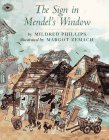
The Sign in Mendel's Window
By Mildred Phillips
A folk-like tale, told with charm and a style apt for its old-world Jewish setting. When
a stranger appears in Kosnov to rent space in Mendel's butcher shop, he says his
work is thinking. But it seems to be making trouble, for after overhearing Mendel
count his weekly earnings, he borrows a horse, goes to the city and returns with two
policemen, claiming the money is his and telling them to arrest Mendel. The entire
village supports Mendel, but it is Molly, Mendel's wife, who proves his innocence.
Zemach's watercolors vividly capture the atmosphere of village life with both humor
and affectionchickens in the street, Mendel making frankfurters, the expressions on
people's faces. Rich browns and purples predominate in the weathered wooden
buildings and street scenes, but there is an effective use of pastels and a bit of brilliant
color. These illustrations seem so perfect for the text that one cannot imagine any
others. Children will relish the outwitting of the villain and enjoy coming back to
these pictures again and again.
Description from School Library Journal
Although young readers might be put off at first by the use, without explanation, of the
Polish term for currency--zloty--the meaning of the word becomes clear as the story
progresses, and the narrative has enough wit and suspense to keep them enthralled.
Margot Zemach's buoyant illustrations help Mendel,Molly and the others come alive
as delightful characters who learn the hard way that not everyone is as caring and
trustworthy as one's own friends. Especially wonderful are Miss Zemach's contrasts
between the naive Mendel and the cunning Tinker.
Description from New York Times Book Review

The Cow in the House
Level 1 (Puffin Easy-To-Read)
By Harriet Ziefert
"Once upon a time a man lived in a noisy house", or so he thought.
The man, who thinks his creaky, squeaky, leaky house is just too
noisy, seeks the advice of the wisest man in town and is shocked
by his advice but desperate enough to try anything. Readers will
find that they, as well as the man, have much to learn about what
real noise is as they follow him in his crazy quest for a quiet
house. Simple repetitive text and a predictable story line make
this an excellent choice for blossoming young readers.
Description from Children's Literature
In this traditional Jewish folktale, a man consults a wise man
about his noisy house. Following the silly-sounding advice, the
man finds his house gets a lot noisier before things finally
quiet down. The bold, colorful artwork with thick black outlines
is inviting. Ziefert's bare-bones text may disappoint those
familiar with the story, but beginning readers should have no
trouble with this simple retelling.
Description from Horn Book
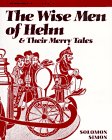
The Wise Men of Helm and Their Merry Tales
By Solomon Simon
The collection of Jewish folk tales that the New York Times
called "a delightful little book . . . a classic of its kind . . .
full of merriment and wisdom." Illustrated with whimsical drawings,
these humorous stories are just right for children.
Description from Publisher
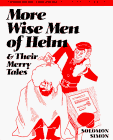
More Wise Men of Helm and Their Merry Tales
By Solomon Simon
Continuing the adventures of the lovable "fools" of Helm
begun in The
Wise Men of Helm, this book is
illustrated with whimsical drawings. These humorous
stories are just right for children.
Description from Publisher

Old Turtle
By Douglas Wood
In a poetic fable, all creation debates the nature of G-d, each
thing imagining that G-d reflects its own image: the antelope
insists that G-d "is a runner, swift and free," while the willow
murmurs that "She is a great tree...always growing, always giving."
The wise old turtle ends the argument: G-d is all these things, and
more. She also makes a prediction: "There will soon be a new family
of beings" who will be reminders of what G-d is. However, the people
in turn begin to argue about G-d, and also to harm the rest of
creation. Then the ocean, the breeze, and even the stars remind them
of G-d's presence and love, and in time the people begin to listen.
Wood's graceful phrasing and understated irony give his plea unusual
power, especially as complemented by Chee's outstanding watercolors,
joyfully celebrating the world's beauty; his portraits of Old Turtle
are masterfully detailed and delightfully subtle. A handsome,
thought-provoking book, especially appropriate for collections that
support religious instruction.
Description from Kirkus Reviews
When all of creation--trees, stones, ants, the sky, fish—-begins arguing over who or what G-d is, quiet Old Turtle is the only one who has the wisdom and ability to see beyond herself to capture the essence. The debate escalates until Old Turtle finally speaks: "STOP!" She accepts and incorporates the beliefs of all the creatures: "G-d is indeed deep," she says to the fish in the sea, "and much higher than high," she tells the mountains. "G-d is gentle and powerful. Above all things and within all things... G-d IS." Old Turtle, after silencing the crowds with her understanding, makes a prediction about the appearance of a new "family of beings" in the world. These beings, human beings, do appear, and soon are fighting among themselves over the nature of G-d. It is only when people start listening to the mountains and winds and stones and stars that they actually begin to hear--and to heal the earth.
A graceful fable, with elegant, dreamlike watercolors by illustrator Cheng-Khee Chee, Douglas Wood's modern-day classic makes a hushed but strong environmental statement, as well as a plea for universal acceptance.
Description from Amazon.com
Page 1 |
Page 2 |
Page 3 |
Page 4 |
Page 5 |
Page 6 |
Page 7
Still can't find what you're looking for? Search Amazon.com's database directly.
©1999-2009
(NOTE: The following links have NOT been placed on the site by the website owners. We have no control over which ads are selected and are not responsible for their religious content.)
If this page came up without frames, Click here to see the complete website
Other Pages of Interest:
Jewish Folktales and Talmudic Stories for Children
(Page 1)
(Page 2)
(Page 3)
(Page 4)
(Page 5)
(Page 6)
(Page 7)
Easy Reader and Picture Books:
Jewish Children's Books (General) |
Jewish Board Books |
Biblical Stories for Children |
Jewish Holiday Books |
Jewish Family Cookbooks |
Jewish Folktales and Talmudic Stories for Children
(Page 1)
(Page 2)
(Page 3)
(Page 4)
(Page 5)
(Page 6)
(Page 7)
|
Jewish Life Books (Mitzvot, Keeping Kosher, etc.) |
Jewish Life Cycle Books |
Family Haggadahs |
Children's Prayerbooks |
Introductory Hebrew Books |
Jewish History and Historical Fiction Picture Books |
Israel Books
Middle School and YA Books:
Bar Mitzvah Books |
Jewish Fiction |
Historical Fiction |
Torah Study |
Prayer and Jewish Life Books |
Jewish Holidays |
Jewish Biographies |
Jewish History Books |
Holocaust Books for Teens |
Israel Books
Jewish Books for Children |
Bar Mitzvah Books |
Jewish Parenting Books |
Jewish Music for Children |
Jewish Videos |
Jewish Toys and Gifts |
Jewish Gift Baskets and Gourmet Food |
Jewish Jewelry |
Amazon.com Coupons, Promotions, and Sales
Other Pages of Interest:
Jewish Folktales and Talmudic Stories for Children
(Page 1)
(Page 2)
(Page 3)
(Page 4)
(Page 5)
(Page 6)
(Page 7)
Easy Reader and Picture Books:
Jewish Children's Books (General) |
Jewish Board Books |
Biblical Stories for Children |
Jewish Holiday Books |
Jewish Family Cookbooks |
Jewish Folktales and Talmudic Stories for Children
(Page 1)
(Page 2)
(Page 3)
(Page 4)
(Page 5)
(Page 6)
(Page 7)
|
Jewish Life Books (Mitzvot, Keeping Kosher, etc.) |
Jewish Life Cycle Books |
Family Haggadahs |
Children's Prayerbooks |
Introductory Hebrew Books |
Jewish History and Historical Fiction Picture Books |
Israel Books
Middle School and YA Books:
Bar Mitzvah Books |
Jewish Fiction |
Historical Fiction |
Torah Study |
Prayer and Jewish Life Books |
Jewish Holidays |
Jewish Biographies |
Jewish History Books |
Holocaust Books for Teens |
Israel Books
Jewish Books for Children |
Bar Mitzvah Books |
Jewish Parenting Books |
Jewish Music for Children |
Jewish Videos |
Jewish Toys and Gifts |
Jewish Gift Baskets and Gourmet Food |
Jewish Jewelry |
Amazon.com Coupons, Promotions, and Sales
Easy Reader and Picture Books:
Jewish Children's Books (General) | Jewish Board Books | Biblical Stories for Children | Jewish Holiday Books | Jewish Family Cookbooks | Jewish Folktales and Talmudic Stories for Children (Page 1) (Page 2) (Page 3) (Page 4) (Page 5) (Page 6) (Page 7) | Jewish Life Books (Mitzvot, Keeping Kosher, etc.) | Jewish Life Cycle Books | Family Haggadahs | Children's Prayerbooks | Introductory Hebrew Books | Jewish History and Historical Fiction Picture Books | Israel Books
Middle School and YA Books:
Bar Mitzvah Books | Jewish Fiction | Historical Fiction | Torah Study | Prayer and Jewish Life Books | Jewish Holidays | Jewish Biographies | Jewish History Books | Holocaust Books for Teens | Israel Books
Jewish Books for Children | Bar Mitzvah Books | Jewish Parenting Books | Jewish Music for Children | Jewish Videos | Jewish Toys and Gifts | Jewish Gift Baskets and Gourmet Food | Jewish Jewelry | Amazon.com Coupons, Promotions, and Sales
 Joseph the Tailor: And Other Jewish Tales Book and Audio Cassette By Syd Lieberman |
Which is your favorite story from Jewish folklore: The story of Joseph,
the tailor who was as resourceful as he was reverent? Or the story of
the wise shoemaker who, when invited to a wedding feast, knew how to
feed his host's appreciation of fine apparel? Whether your favorite is
one of these, or one of the ten other stories in this award-winning
collection, you're sure to be enchanted by Syd Lieberman's mesmerizing
voice, a voice that folklorist Joseph Sobol calls "a powerful tenor
instrument."
Here is the wit and wisdom of traditional Jewish and Biblical stories in an ALA Notable Children's Recording. Includes 12 stories. |
 The Rabbi Who Flew By Renate Dollinger |
With a playful magic realism reminiscent of the work of Singer and Chagall, Grandma tells a story of a rabbi in the shtetl who is so holy that he flies. The shoemaker's son notices that the rebbe has holes in the soles of his shoes. People will look up at the soaring rebbe, see his shoes, and then what will they think? So the shoemaker and his son devise a plan to measure and mend the rebbe's soles. It's more a scenario than a developed story, but it's told in Grandma's warm Yiddish idiom: the shoemaker's family is beautiful, "may they live to one hundred and twenty." Best of all are Dollinger's vibrant expressionist paintings in rich gouache colors, highlighted with thick black lines. They are packed with people and action, and whether the setting is the street, the crowded shul, or the shoemaker's Shabbat dinner table, the pictures capture the magic that is part of daily life.
Written and illustrated by Renate Dollinger, a highly acclaimed Jewish painter, The Rabbi Who Flew is the first in a planned series of "Grandma Hanne Sheyne Stories," and just received a Pewter award in the 2001 Gold Ink Awards Competition (Children's Book). A closer look at the expressive color artwork and rapturous tale reveals why this children's story deserves such an honor. It seems that when Rabbi Frum prays very hard he flies! The problem is that Reb Finkel (the only shoemaker in the village of Gil) is worried that someone looking up as the Rabbi flies over would notice that he had holes in his shoes! What would people think of the "holy" Rabbi then? The Rabbi Who Flew is charmingly presented, exciting, and a highly enjoyable story for young people, presented in such a way as to evoke an atmosphere of Jewish folklore. |
 > >Onions and Garlic : An Old Tale By Eric A. Kimmel |
A classic tale about the fool who makes good, while his acquisitive older brothers
are left holding the bag. Kindhearted Getzel is a poor merchant, for he's so eager
to please his customers that he ends up losing money in any bargain. When his
father refuses to give him anything to trade, Getzel begs for some cheap goods and
sets sail with a bag of onions. Value is relative: Getzel is shipwrecked on an
island where onions are an unknown delicacy and diamonds are mere rocks for the
picking. Getzel makes the trade of a lifetime and returns home in triumph. Kimmel
(The
Adventures of Hershel of Ostropol, 1995, etc.) retells this Jewish folktale
(carefully sourced in an author's note) with lively dialogue and a comic twist at
the end.
|
 The Peddler's Gift By Maxine Rose Schur |
This new version of a wise fool story originally published as
Shnook
the Peddler (1985), is illustrated in pencil and watercolors that show the
shtetl setting and introduce the characters with gentle humor and grace. A
boy, Leibush, describes how everyone considers the meek peddler
Shimon ("Shnook") from Pinsk to be a simpleton. Nothing he does turns
out right. Other peddlers are jolly entertainers, but Shnook is shy,
trusting, unlucky. One night Leibush steals a dreidel from the peddler.
Racked by guilt, the boy goes out into the stormy night to return it and
finds Shimon alone in the synagogue, singing in a beautiful, vibrant voice.
Shimon is glad that Leibush is not a good thief. They shelter together in
the synagogue, and the boy realizes that the unworldly peddler is wise,
strong, and kind. The detailed, realistic pictures express the quiet
humanity of the story in soft tones of grey and blue--except for the
storm scene, when the boy learns the truth and the world is bathed in
holy light.
|
 The Kingfisher Treasury of Jewish Stories By Jane Cope |
Ranging from folktales to contemporary stories, this anthology celebrates the richness of the Jewish heritage. The stellar list of contributors includes Isaac Bashevis Singer, Lynn Reid Banks, and Michael Rosen.
|
 Bone Button Borscht By Aubrey Davis |
In this ethnic variation of "Stone Soup," a hungry beggar comes to a poor town
on a cold and snowy evening. No door is opened to him until he sees a light and
enters the synagogue. The shamas does not answer his greeting so the beggar takes
the five buttons off his coat and asks for one more in order to make Bone Button
Borscht. Bowls, cups, ladles, and a pot wouldn't hurt either, he explains. As the
shamas goes from door to door seeking the ingredients, the incredulous townspeople
gather round and provide the food that will make the soup just a little more tasty.
Such a miracle. Such a joyous feast. The stranger then goes on his way with better
buttons on his coat and the townspeople left with a better spirit of neighborliness.
The retelling provides a satisfying Eastern European setting for a classic folktale.
Watercolor and pencil drawings help to flavor the stew
|
 G-d in Between By Sandy Eisenberg Sasso |
In a town with no roads and few windows live adults of various races, all
of whom are in search of G-d to build windows and roads for them. The two
residents who have a window in their homes are designated to find G-d. Each
travels far and endures nature's extremes en route, but neither searcher is
successful. Meeting after their exhausting quests, the two spend hours
comforting each other before returning home. The disappointed townspeople
continue to complain about their windowless, roadless existence, while the
two searchers help each other build a road and put windows in each room of
their homes. When asked how they accomplished this daunting feat, they
replied that G-d helped them, for "G-d is in the between. In between us."
Reflecting the author's weighty message with heavy brushstrokes, Sweetland
thickly paints a multicultural populace in a nondescript environment.
Although the message is didactic, this nonsectarian urging to look beyond
oneself, to look to help others and thereby find G-d will be welcomed by
fans of Sasso's
G-d's
Paintbrush (1995) and
Prayer
for the Earth (1997).
|
 > >
A Treasury of Jewish Stories By Adele Geras |
Ranging from folktales to contemporary stories, this anthology celebrates the richness of Jewish tradition. The stellar list of contributors includes Isaac Bashevis Singer, Lynne Reid Banks, and Michael Rosen. |
 Naftali the Storyteller and His Horse, Sus and Other Stories By Isaac Bashevis Singer |
A collection of short stories which explores the humor and life of the people of Poland. |
 Just Stay Put : A Chelm Story By Gary Clement |
Chelm, that village of "extremely silly", is the setting of a
splendidly idiotic tale of Mendel, a lazy man with his head
literally in the clouds. After five pages of background
in the ways of Chelm, the real story gets under way: Mendel
embarks on a journey to Warsaw, the city of his dreams. He
takes time for a nap on the way, but points his shoes toward
Warsaw so he won't forget which way he was walking. A would-be
thief examines the shoes and replaces them, pointing Mendel
toward home. This fool, believing he has arrived in Warsaw,
is amazed to find things exactly as they were in Chelm (right
down to the "twin" of his wife), and decides that "if one
place is exactly like every other place, one might as well
just stay put." Clement's witty illustrations depict Mendel
sometimes towering over the village, sometimes in miniature
among giants, always slightly dazed.
|
 I'll Tell You a Story: Tales from the Jewish Tradition By Marc-Alain Ouaknin |
The story of Maimonides, whose morality was tested by a sultan, and other traditional Jewish tales. |
 Stories from Our Living Past By Francine Prose |
Twenty-eight tales from the aggadic treasury of lore and legend
that the rabbis called "the Torah of the Heart"--and the moral
lessons they teach. Retold and illustrated for grades 2-3, and
ranging from the Binding of Isaac to Bialik's "moral myth" about
the Dukes of Onion and Garlic. (Pupils will find there is even a
moral lesson in the traditional recipe for tsimmes.)
|
 Legends of the Chinese Jews of Kaifeng By Xin Xu and Beverly Friend |
Chinese Jews!
A curious pairing, but strange as it may seem, there have been Jews in China for more than a thousand years. The country's Jewish community, located in Kaifeng, once the capital city, numbered several thousand at its height. Because of China's tolerance and openness, its members attained success in many fields - commerce, crafts, government service, the military. Their synagogue, a unique amalgam of Chinese architecture with Judaic tradition, was one of the city's most striking sights. The story of Chinese Jewry is both historically interesting and profoundly inspiring. Long isolated from other Jews because they were living in a land that sought to cut itself off from the rest of the world, they tenaciously maintained their traditions and identity. Though they adopted Chinese customs and intermarried with their neighbors, Kaifeng's Jews held together as a community until well into modern times. Even today there are people in Kaifeng who remain aware of their ancestry and register as Jews on official census forms. Of the many fascinating tales related in this beautifully illustrated, lovingly written book, perhaps the most touching is the one about Kaifeng's Jews and the first Christian missionaries in China. The Jews, never having heard of Christianity, assumed that anyone who believed in one God must be a coreligionist. The missionaries, never having imagined there might be Jews in China, assumed they were lost Christians. When the misunderstanding was cleared up, the Christians set about trying to convert the Jews but to no avail, because Kaifeng's Jews were adamantly loyal to their heritage. |
 Brainteasers from Jewish Folklore By Rosalind Charney Kaye |
A lavishly-illustrated collection of folktale riddles in which peasants
outsmart kings, cope with noblemen, and show uncommon wisdom
in the face of adversity. Young readers are challenged to answer the
clever riddles that end each story.
|
 The Sign in Mendel's Window By Mildred Phillips |
A folk-like tale, told with charm and a style apt for its old-world Jewish setting. When
a stranger appears in Kosnov to rent space in Mendel's butcher shop, he says his
work is thinking. But it seems to be making trouble, for after overhearing Mendel
count his weekly earnings, he borrows a horse, goes to the city and returns with two
policemen, claiming the money is his and telling them to arrest Mendel. The entire
village supports Mendel, but it is Molly, Mendel's wife, who proves his innocence.
Zemach's watercolors vividly capture the atmosphere of village life with both humor
and affectionchickens in the street, Mendel making frankfurters, the expressions on
people's faces. Rich browns and purples predominate in the weathered wooden
buildings and street scenes, but there is an effective use of pastels and a bit of brilliant
color. These illustrations seem so perfect for the text that one cannot imagine any
others. Children will relish the outwitting of the villain and enjoy coming back to
these pictures again and again.
Although young readers might be put off at first by the use, without explanation, of the Polish term for currency--zloty--the meaning of the word becomes clear as the story progresses, and the narrative has enough wit and suspense to keep them enthralled. Margot Zemach's buoyant illustrations help Mendel,Molly and the others come alive as delightful characters who learn the hard way that not everyone is as caring and trustworthy as one's own friends. Especially wonderful are Miss Zemach's contrasts between the naive Mendel and the cunning Tinker. |
 The Cow in the House Level 1 (Puffin Easy-To-Read) By Harriet Ziefert |
"Once upon a time a man lived in a noisy house", or so he thought.
The man, who thinks his creaky, squeaky, leaky house is just too
noisy, seeks the advice of the wisest man in town and is shocked
by his advice but desperate enough to try anything. Readers will
find that they, as well as the man, have much to learn about what
real noise is as they follow him in his crazy quest for a quiet
house. Simple repetitive text and a predictable story line make
this an excellent choice for blossoming young readers.
In this traditional Jewish folktale, a man consults a wise man about his noisy house. Following the silly-sounding advice, the man finds his house gets a lot noisier before things finally quiet down. The bold, colorful artwork with thick black outlines is inviting. Ziefert's bare-bones text may disappoint those familiar with the story, but beginning readers should have no trouble with this simple retelling. |
 The Wise Men of Helm and Their Merry Tales By Solomon Simon |
The collection of Jewish folk tales that the New York Times
called "a delightful little book . . . a classic of its kind . . .
full of merriment and wisdom." Illustrated with whimsical drawings,
these humorous stories are just right for children.
|
 More Wise Men of Helm and Their Merry Tales By Solomon Simon |
Continuing the adventures of the lovable "fools" of Helm
begun in The
Wise Men of Helm, this book is
illustrated with whimsical drawings. These humorous
stories are just right for children.
|
 Old Turtle By Douglas Wood |
In a poetic fable, all creation debates the nature of G-d, each
thing imagining that G-d reflects its own image: the antelope
insists that G-d "is a runner, swift and free," while the willow
murmurs that "She is a great tree...always growing, always giving."
The wise old turtle ends the argument: G-d is all these things, and
more. She also makes a prediction: "There will soon be a new family
of beings" who will be reminders of what G-d is. However, the people
in turn begin to argue about G-d, and also to harm the rest of
creation. Then the ocean, the breeze, and even the stars remind them
of G-d's presence and love, and in time the people begin to listen.
Wood's graceful phrasing and understated irony give his plea unusual
power, especially as complemented by Chee's outstanding watercolors,
joyfully celebrating the world's beauty; his portraits of Old Turtle
are masterfully detailed and delightfully subtle. A handsome,
thought-provoking book, especially appropriate for collections that
support religious instruction.
When all of creation--trees, stones, ants, the sky, fish—-begins arguing over who or what G-d is, quiet Old Turtle is the only one who has the wisdom and ability to see beyond herself to capture the essence. The debate escalates until Old Turtle finally speaks: "STOP!" She accepts and incorporates the beliefs of all the creatures: "G-d is indeed deep," she says to the fish in the sea, "and much higher than high," she tells the mountains. "G-d is gentle and powerful. Above all things and within all things... G-d IS." Old Turtle, after silencing the crowds with her understanding, makes a prediction about the appearance of a new "family of beings" in the world. These beings, human beings, do appear, and soon are fighting among themselves over the nature of G-d. It is only when people start listening to the mountains and winds and stones and stars that they actually begin to hear--and to heal the earth. A graceful fable, with elegant, dreamlike watercolors by illustrator Cheng-Khee Chee, Douglas Wood's modern-day classic makes a hushed but strong environmental statement, as well as a plea for universal acceptance. |